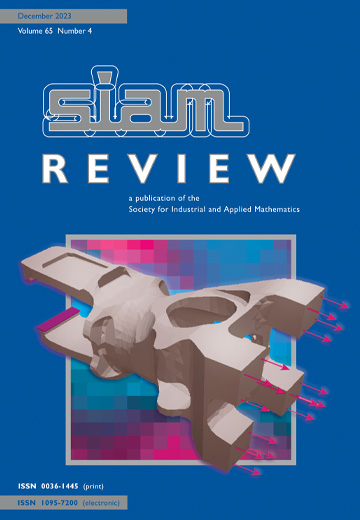研究热点
IF 6.1
1区 数学
Q1 MATHEMATICS, APPLIED
引用次数: 0
摘要
SIAM 评论》,第 66 卷第 4 期,第 681-681 页,2024 年 11 月。 对数变换广泛应用于数据科学、数学和工程领域,但它仍能揭示看似毫不相干的学科之间的惊人联系。本期第一个研究热点 "西格米函数、奇点的多尺度解析和$hp$-网格细化 "揭示了变量$s = \log(x)$ 的变化如何将计算数学的不同领域联系起来。作者达安-胡伊布雷斯和劳埃德-"尼克"-特雷费特展示了平滑逼近、有理逼近理论、自适应网格细化和数值正交之间的新关系。例如,作者展示了这种变量变化可以自然地与奇点附近的 "线性渐变 "效应联系起来,而这正是理性逼近和 $hp$ 网格细化的共同特征。通过一些有效的例子,作者说明了这些关系在相对独立发展的领域中的力量。在此过程中,作者提出了利用新联系开发和分析新方法的机会,包括网格细化策略、多元逼近技术以及结合不同方法优势的混合方法。从水波中恢复信息的效果如何?这个问题正是本期第二个研究热点 "费曼的逆问题 "的核心所在。作者阿德里安-柯克比(Adrian Kirkeby)的灵感来自物理学家、偶像派人物理查德-费曼(Richard Feynman)提出的一个思想实验:一只漂浮在游泳池中的昆虫希望确定其他人在何时何地跳入游泳池,从而引起昆虫观察到的水波。柯克比构建并分析了前向模型的线性 2D-3D 偏微分方程(PDE)系统。利用这个偏微分方程系统的非局部性,柯克比展示了在哪些条件下,昆虫只需观察水面上任何一小块区域的波幅和水流速度,就能确定波浪的来源--事实上是唯一的来源。这一模型随后被扩展到收集噪声观测数据和在有限数量的时间和空间点上进行观测的情况,并为重建建立了稳定性和误差边界。论文最后以基于非谐波傅立叶反演方法的数值实验作了说明。Kirkeby 还强调了未来研究的几个方向,指出与声波或电磁波相比,水波或其他表面波的反演问题受到的关注较少。作为额外的奖励,引用的费曼视频也不容错过。本文章由计算机程序翻译,如有差异,请以英文原文为准。
Research Spotlights
SIAM Review, Volume 66, Issue 4, Page 681-681, November 2024.
Logarithmic transformations are used broadly in data science, mathematics, and engineering, and yet they can still reveal surprising connections between seemingly unrelated disciplines. This issue's first research spotlight, “Sigmoid Functions, Multiscale Resolution of Singularities, and $hp$-Mesh Refinement,” illuminates how the change of variables $s = \log(x)$ connects different areas of computational mathematics. Authors Daan Huybrechs and Lloyd “Nick” Trefethen show new relationships between smooth approximation, rational approximation theory, adaptive mesh refinement, and numerical quadrature. For example, the authors show that this change of variables can be naturally tied to a “linear tapering” effect near singularities, which is a common feature in both rational approximation and $hp$-mesh refinement. Through a number of effective examples, the authors illustrate the power of these relationships across areas that have seen relatively independent lines of development. In doing so, the authors suggest opportunities for developing and analyzing new methods by leveraging the new connections, including mesh refinement strategies, techniques for multivariate approximation, and hybrid approaches that combine the strengths of disparate methods. How well can information be recovered from water waves? This question is at the heart of this issue's second research spotlight, “Feynman's Inverse Problem.” Author Adrian Kirkeby is motivated by a thought experiment posed by the physicist and iconoclast Richard Feynman wherein an insect floating in a swimming pool wants to determine where and when others have jumped into the pool, causing the waves the insect observes. Kirkeby constructs and analyzes a linear 2D-3D system of partial differential equations (PDEs) for the forward model. Leveraging the nonlocality of this system of PDEs, Kirkeby shows conditions under which the insect can determine the source of the waves---in fact, uniquely---simply by observing the wave amplitude and water velocity in any small area of the surface. This model is then extended to capture settings where noisy observations and observations at a finite number of time and space points are collected, and establishes stability properties and error bounds for the reconstruction. The paper concludes with illustrative numerical experiments based on a nonharmonic Fourier inversion method. Kirkeby also highlights several avenues for future research, noting that inverse problems for water or other surface waves have received less attention than those involving acoustic or electromagnetic waves. As an added bonus, the referenced video of Feynman is not to be missed.
Logarithmic transformations are used broadly in data science, mathematics, and engineering, and yet they can still reveal surprising connections between seemingly unrelated disciplines. This issue's first research spotlight, “Sigmoid Functions, Multiscale Resolution of Singularities, and $hp$-Mesh Refinement,” illuminates how the change of variables $s = \log(x)$ connects different areas of computational mathematics. Authors Daan Huybrechs and Lloyd “Nick” Trefethen show new relationships between smooth approximation, rational approximation theory, adaptive mesh refinement, and numerical quadrature. For example, the authors show that this change of variables can be naturally tied to a “linear tapering” effect near singularities, which is a common feature in both rational approximation and $hp$-mesh refinement. Through a number of effective examples, the authors illustrate the power of these relationships across areas that have seen relatively independent lines of development. In doing so, the authors suggest opportunities for developing and analyzing new methods by leveraging the new connections, including mesh refinement strategies, techniques for multivariate approximation, and hybrid approaches that combine the strengths of disparate methods. How well can information be recovered from water waves? This question is at the heart of this issue's second research spotlight, “Feynman's Inverse Problem.” Author Adrian Kirkeby is motivated by a thought experiment posed by the physicist and iconoclast Richard Feynman wherein an insect floating in a swimming pool wants to determine where and when others have jumped into the pool, causing the waves the insect observes. Kirkeby constructs and analyzes a linear 2D-3D system of partial differential equations (PDEs) for the forward model. Leveraging the nonlocality of this system of PDEs, Kirkeby shows conditions under which the insect can determine the source of the waves---in fact, uniquely---simply by observing the wave amplitude and water velocity in any small area of the surface. This model is then extended to capture settings where noisy observations and observations at a finite number of time and space points are collected, and establishes stability properties and error bounds for the reconstruction. The paper concludes with illustrative numerical experiments based on a nonharmonic Fourier inversion method. Kirkeby also highlights several avenues for future research, noting that inverse problems for water or other surface waves have received less attention than those involving acoustic or electromagnetic waves. As an added bonus, the referenced video of Feynman is not to be missed.
求助全文
通过发布文献求助,成功后即可免费获取论文全文。
去求助
来源期刊

SIAM Review
数学-应用数学
CiteScore
16.90
自引率
0.00%
发文量
50
期刊介绍:
Survey and Review feature papers that provide an integrative and current viewpoint on important topics in applied or computational mathematics and scientific computing. These papers aim to offer a comprehensive perspective on the subject matter.
Research Spotlights publish concise research papers in applied and computational mathematics that are of interest to a wide range of readers in SIAM Review. The papers in this section present innovative ideas that are clearly explained and motivated. They stand out from regular publications in specific SIAM journals due to their accessibility and potential for widespread and long-lasting influence.
 求助内容:
求助内容: 应助结果提醒方式:
应助结果提醒方式:


